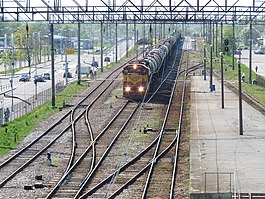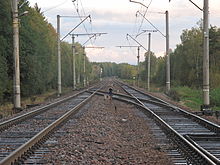| Tallinn–Tapa railway | |
|---|---|
 Tallinn–Tapa railway at Ülemiste station Tallinn–Tapa railway at Ülemiste station | |
| Overview | |
| Status | Operational |
| Owner | Eesti Raudtee |
| Locale | Estonia (Harju County, Lääne-Viru County) |
| Termini | |
| Stations | 17 |
| Service | |
| Type | Regional rail Commuter rail Freight rail |
| Route number |
List of routes
|
| Operator(s) | GoRail Elron EVR Cargo |
| Depot(s) | Tallinn Baltic Station Tapa railway station |
| Rolling stock | 2TE116 DR1A (withdrawn) DR1B (withdrawn) Stadler FLIRT (from 2012) ER2 (withdrawn) GE C36-7i GE C30-7Ai ChME3 M62 (withdrawn) |
| History | |
| Opened | 1870 |
| Technical | |
| Track length | 77.8 km (48.3 mi) |
| Number of tracks | Double track |
| Track gauge | 1,520 mm (4 ft 11+27⁄32 in) Russian gauge |
| Electrification | 3 kV DC OHLE (Tallinn to Aegviidu) 25 kV AC OHLE (to be installed 2021-2024) |
| Operating speed | 120 km/h (75 mph) (operational) 135 km/h (84 mph) (planned) 160 km/h (99 mph) (long-term planned) |
| Tallinn–Tapa railway | ||||||||||||||||||||||||||||||||||||||||||||||||||||||||||||||||||||||||||||||||||||||||||||||||||||||||||||||||||||||||||||||||||||||||||||||||||||||||||||||||||||||||||||||||||||||||||||||||||||||||||||||||||||||||||||||||||||||||||||||||||||||||||||||||||||||||||||||||||||||||||||||||||||||||||||||||||||||||||||||||||||||||||||||||||||||||||||||||||||||||||||||||||||||||||||||||||||||||||
|---|---|---|---|---|---|---|---|---|---|---|---|---|---|---|---|---|---|---|---|---|---|---|---|---|---|---|---|---|---|---|---|---|---|---|---|---|---|---|---|---|---|---|---|---|---|---|---|---|---|---|---|---|---|---|---|---|---|---|---|---|---|---|---|---|---|---|---|---|---|---|---|---|---|---|---|---|---|---|---|---|---|---|---|---|---|---|---|---|---|---|---|---|---|---|---|---|---|---|---|---|---|---|---|---|---|---|---|---|---|---|---|---|---|---|---|---|---|---|---|---|---|---|---|---|---|---|---|---|---|---|---|---|---|---|---|---|---|---|---|---|---|---|---|---|---|---|---|---|---|---|---|---|---|---|---|---|---|---|---|---|---|---|---|---|---|---|---|---|---|---|---|---|---|---|---|---|---|---|---|---|---|---|---|---|---|---|---|---|---|---|---|---|---|---|---|---|---|---|---|---|---|---|---|---|---|---|---|---|---|---|---|---|---|---|---|---|---|---|---|---|---|---|---|---|---|---|---|---|---|---|---|---|---|---|---|---|---|---|---|---|---|---|---|---|---|---|---|---|---|---|---|---|---|---|---|---|---|---|---|---|---|---|---|---|---|---|---|---|---|---|---|---|---|---|---|---|---|---|---|---|---|---|---|---|---|---|---|---|---|---|---|---|---|---|---|---|---|---|---|---|---|---|---|---|---|---|---|---|---|---|---|---|---|---|---|---|---|---|---|---|---|---|---|---|---|---|---|---|---|---|---|---|---|---|---|---|---|---|---|---|---|---|---|---|---|---|---|---|---|---|---|---|---|---|---|---|---|---|---|---|---|---|---|---|---|---|---|---|---|---|---|---|---|---|---|---|---|---|---|---|---|---|---|---|---|---|---|---|---|---|---|---|---|---|
| Legend | ||||||||||||||||||||||||||||||||||||||||||||||||||||||||||||||||||||||||||||||||||||||||||||||||||||||||||||||||||||||||||||||||||||||||||||||||||||||||||||||||||||||||||||||||||||||||||||||||||||||||||||||||||||||||||||||||||||||||||||||||||||||||||||||||||||||||||||||||||||||||||||||||||||||||||||||||||||||||||||||||||||||||||||||||||||||||||||||||||||||||||||||||||||||||||||||||||||||||||
| ||||||||||||||||||||||||||||||||||||||||||||||||||||||||||||||||||||||||||||||||||||||||||||||||||||||||||||||||||||||||||||||||||||||||||||||||||||||||||||||||||||||||||||||||||||||||||||||||||||||||||||||||||||||||||||||||||||||||||||||||||||||||||||||||||||||||||||||||||||||||||||||||||||||||||||||||||||||||||||||||||||||||||||||||||||||||||||||||||||||||||||||||||||||||||||||||||||||||||
The Tallinn–Tapa railway is a 77.8-kilometre (48.3 mi) long double track partly electrified railway line in Estonia, connecting the cities of Tallinn and Tapa.
Operational use
The line starts at Tallinn Baltic Station, runs through Northern Estonia in eastern direction and ends in Tapa, where it connects with railways to Narva and Tartu. It has 17 stations, including its two termini. The line is equipped for speeds up to 120 km/h on its entire length. Ülemiste train station and Tallinn Baltic Station are included into planned Rail Baltica high-speed standard gauge railway. Passenger train operators include Elron and GoRail. Lux Express announced its plans to operate the line between Tallinn and St. Petersburg with two Stadler trains. The line has a railway connection, which serves Muuga Harbour, the largest cargo port in Estonia. Large marshalling yards are at Tallinn Baltic Station, Ülemiste railway station and Tapa railway station.
History
The railway forms together with the Tapa–Narva railway the Tallinn–Narva railway. Its length is 209.6 km (130.2 mi). This line was completed in 1870 and was originally a part of the railway line, which connected St. Peterburg and Paldiski through Tallinn and Narva as a part of the railway network of the Russian Empire.
Future
The second stage of the Rail Baltica development includes the modernisation of Tallinn–Tapa railway as a part of Tallinn–Riga railway, so trains could run at 160 km/h. A new train station is to be built at Ülemiste in 2019, making it the largest station on the line and starting serving the whole region through Rail Baltica HSL in period 2020–2025.
Infrastructure
The railway is maintained from Tallinn Baltic Station and Tapa railway station. The railway infrastructure operator is EVR Infra – a subsidiary of the national railway company Eesti Raudtee. Modernisation of interlocking of the stations will be made in 2014 and implementation of the ETCS second level is dependant from the phase of development of the technology and comes as the third stage of ERMTS implementation plan for Estonian conventional rail network in period 2019–2025.
Track
The track is 1,520 mm (4 ft 11+27⁄32 in) Broad gauge. The line is electrified between Tallinn and Aegviidu using overhead lines with 3 kV DC railway electrification.
Stations
All stations are being rebuilt according to European Council decision 2002/735/EC and Estonian standard EVS 867:2003 from a platform height of 1,100 mm to the EU standard platform height of 550 mm.
Route



From Tallinn Baltic Station, trains travel around the centre of Tallinn through Kitseküla railway station heading eastwards towards Ülemiste train station. After Vesse station they leave borders of Tallinn and continue in a south-eastern direction through Harju County and Lääne-Viru County till Jäneda station, crossing several rivers on their way. After Jäneda the railway runs mainly in eastward direction till the end point in Tapa, where it splits to railways to Tartu and Narva.
As railway electrification ends in Aegviidu, this station serves as a terminus station for Elron EMUs in eastern direction.
Services are operated by Elron Stadler FLIRT trains, which replaced the DMU and EMU rolling stock of Edelaraudtee and Elektriraudtee.
See also
References
- "Elektriraudtee and Stadler signed the procurement contract for the new FLIRT trains". Estonia. 4 August 2010. Archived from the original on 19 February 2014.
- "MONITORING OF DEVELOPMENTS RELEVANT FOR THE PAN-EUROPEAN TRANSPORT CORRIDORS AND AREAS". www.unece.org. 30 June 2006. Retrieved 19 June 2012.
- "Lux Express hangib raudteeärisse sisenemiseks kaks luksusrongi" [Lux Express acquires two luxury trains to enter the rail business]. Delfi (in Estonian). 28 February 2012.
- "The government approved Estonia's plans for railway developments". Estonia. 1 February 2022.
- "Tallinn algatab Ülemiste supervaksali planeeringu" [Tallinn initiates the planning of the Ülemiste super station]. Delfi (in Estonian). 22 March 2012.
- ^ "Euroopa Ühtekuuluvusfondi kaasfinantseeritud reisiplatvormide projekt". www.evr.ee. Archived from the original on 2016-03-04. Retrieved 11 June 2012.(in Estonian)
- "ERTMS implementation plan for Estonian conventional rail network" (PDF). ec.europa.eu/transport/. Retrieved 11 June 2012.
- "Elektriraudtee orders Stadler Flirt trains". Railway Gazette International. 12 April 2010.